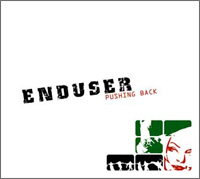
(03.06.07) One of my favorite parts about Enduser so far is the fact that my neighbor kept trying to read “Enduser” as a misspelled “Inducer.” Makes me think: Is space rap/IDM (computer nerd hip-hop, in this case a subgenre of Drum and Bass and a variety of other styles including probably Ambient, Hip Hop, Jazz) and the associated compu-terminology really that esoteric? Yeesh. I guess so. We’re privileged with a secret language, friends! Long live bytes and beeps!
This album brings back all the great memories I have of ambient chord pad sounds generating rich, melodious chord progressions. It reminds me of being high and looking out the window of a spike-wearing girl’s pink 1982 Honda Civic trying desperately to make out with her under the causeway between Sacramento and San Francisco while the most beautiful sunrise of all time happened everywhere. Sometimes it’s like a more minimal deep forest with way cooler drum beats and way more interesting samples because it makes me feel that ambient-soft-love sort of way. Other times, this is deeply contrasted with an angry and powerful beat-whirlwind which doesn’t affront but rather lifts and propels a message of loving all the beauty in the world while being enormously frustrated by its frequent absence. Like Richard James’ “Girl/Boy Song.”
Oh, and I love to hear these guys sampling live drummers. Mmmm, sounds nice.
As with all human expressions, there are two ways to consider Enduser’s Pushing Back: as a single artistic statement, independent of all other such statements, best defined by how it makes me feel, by how I react to it, by what I bring to it; OR as a piece in the world which uses a system of signs and references to communicate a message which can be interpreted somewhat objectively. If you were into theology, you might say that these contrasting ways of examining art can be termed as “eisegesic” versus “exegesic.” I think that the former amounts to me saying things like “Mmmm, sounds like that girl I almost made out with at that rave so many years ago” while I rock back and forth. And for me, this is not any less meaningful a response than a more objective critical approach because, let’s face it, objectivity is a neat idea, but it’s utterly impossible and non-existent and anyone who tells you differently is selling something. A subjective, eisegesic response is in fact the profoundly more meaningful response than a more exegesic listening. Exegesis also makes me think of the word “intertextual:” “when we realize that meaning is not transferred directly from writer to reader but instead is mediated through, or filtered by, ‘codes’ imparted to the writer and reader by other texts” (from Wikipedia’s definition of “Intertextual“). And I’m not talking about mere allusion here, but a system of signs and references which create a language structure or system of meaning in and of themselves. In Pushing Back, I’m hearing beautiful, soft, comforting tones that make me feel good, make me tap my foot, make me think about cool stuff. But I’m also hearing a distinct system of references which I loosely outline in the first two paragraphs of this review and in the “Very Subjective Album Reference Rundown” section of this review which is starting… Now:
Very Subjective Album Reference Rundown ::
So that’s what those tracks make me think of. Electronic music is all about references, samples, and sign systems. Pushing Back reminds me of events in my life and the music I was listening to during those events. “That’s what tradition means!” says Morrissey. You see, when examining something intertextually, I feel like everyone is going to hear a different system of references, based on their personal experiences and exposures, and this makes real objectivity impossible and thus eisegesis and exegesis are sort of the same thing. But you, dear reader, should keep in mind that I’m just making all this up and not representing any sort of academic discipline. It’s all in my head. No wait, it’s all in YOUR head. Uh-oh. I’m just paraphrasing. As critic William Irwin says, the term [intertextual] “has come to have almost as many meanings as users, from those faithful to Kristeva’s original vision to those who simply use it as a stylish way of talking about allusion and influence” (Irwin, 228). Oops. Guilty as charged.
Pushing Back is out now on Ad Noiseam. Buy it at Amazon.com.





















